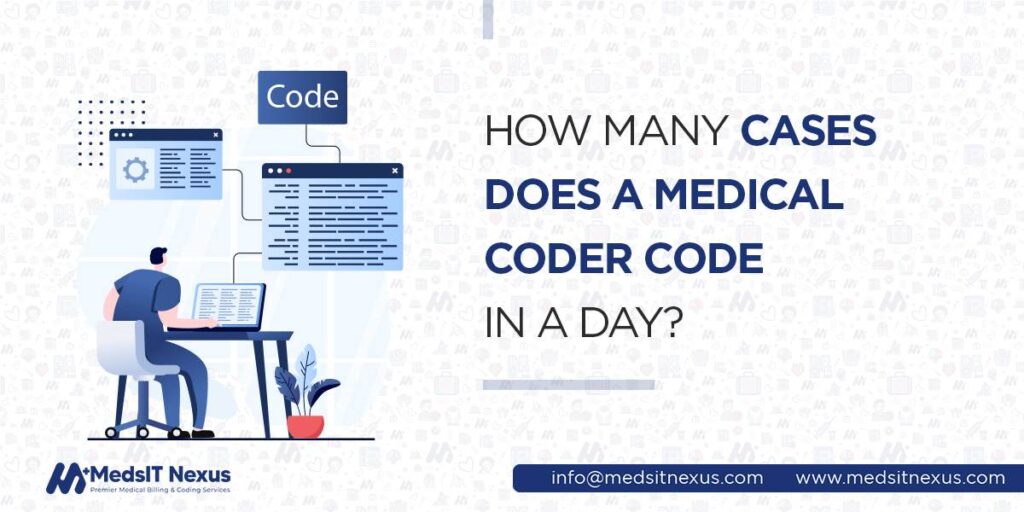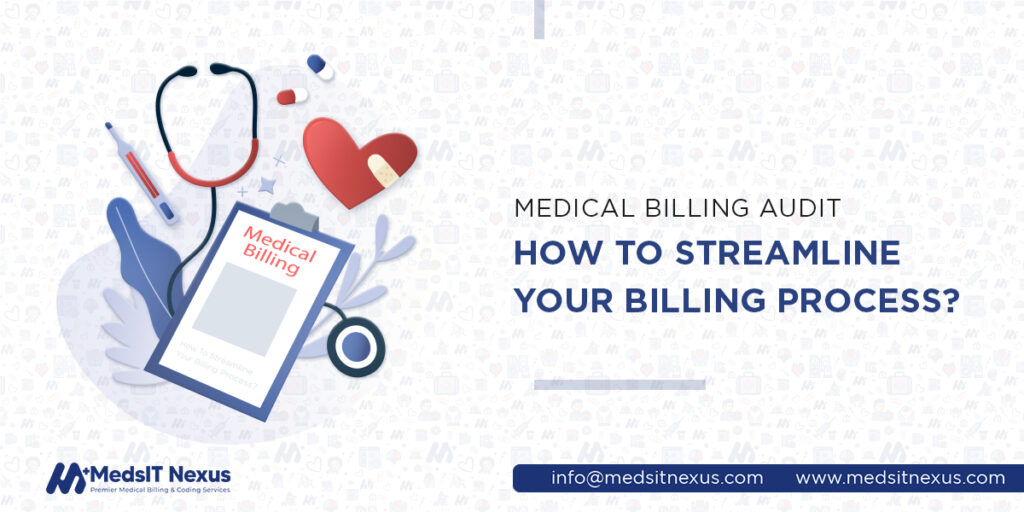How Many Cases does a Medical Coder Code In a Day?

Medical coders are a beneficial asset for healthcare organizations as they
deal with financing departments professionally and efficiently to maintain the RCM of medical practices.
Medical organizations would struggle to maintain accurate patient records without medical coders, and
billing and reimbursement processes could become chaotic and inefficient.
However, many aspiring and practicing medical coders often wonder how many cases they should be able to
code in a day. The answer to this question is not straightforward, as several factors can affect a
coder’s productivity and the number of cases they can handle. This article will explore these factors
and provide insights into how many cases a medical coder can code daily.
How many cases per day?
While there is no one-size-fits-all answer to this question, several factors can influence the number of cases a medical coder can code in a day. However, according to industry standards, a typical medical coder can code between 15 to 25 cases per hour, translating to around 120 to 200 cases per day for an 8-hour shift.
Factors affecting coding productivity
Medical coding productivity standards vary depending on different factors. These factors are significant in determining how many cases can be done by a medical coder in a day.
Experience and Skill
The experience and skill level of the medical coder can impact coding productivity. According to a
survey by
the American Health Information Management Association (AHIMA) in 2016, experienced medical coders are
more
productive than inexperienced coders. The survey found that coders with five or more years of experience
coded
an average of 27.6 charts per day, while coders with less than one year of experience coded an average
of 12.2
charts per day.
New coders may only be able to code 20 to 30 cases per day, while more experienced coders can code 50 or
more
cases. This is because experienced coders are more familiar with the codes and have efficiently
developed
strategies for coding cases. Similarly, medical coders who have received specialized training in certain
areas
of coding, such as inpatient coding or surgery coding, may be able to code more cases per day in
those
areas.
Important Skills for Medical Coders
- Knowledge of Medical Terminology
- Knowledge of Insurance and Billing Procedures
- Time Management Skills
- Adaptability and Flexibility
- Communication Skills
- Computer skills
- Familiarity with Coding Systems (CPT, ICD, HCPCS)
- Analytical Skills
- Attention to Detail
Workplace
Each work setting has unique challenges and benefits, which can affect the number of cases a medical
coder can
code daily.
Hospital
Hospitals are fast-paced work environments that require medical coders to be efficient and accurate in
their
coding.
According to a study published in the Journal of AHIMA, medical coders in hospital settings can code an
average
of 60-80 cases per day, depending on their experience and workload. However, the study also found that
hospital
coders face several challenges that can affect their productivity, including frequent interruptions,
competing
priorities, and complex medical cases.
Clinic
Clinics are smaller healthcare facilities that typically have fewer patients and a more manageable
workload for
medical coders.
According to a survey by the American Academy of Professional Coders (AAPC), medical coders in clinic
settings
can code an average of 30-50 cases per day. The survey also found clinic coders tend to have a more
predictable
workload and fewer interruptions than hospital coders.
Physician Office
The physician office is another work setting for medical coders in which medical coders typically work
closely
with the healthcare provider and may have a smaller workload than hospital and clinic coders.
According to a study published in the Journal of AHIMA, medical coders in physician office settings can
code an
average of 20-30 cases daily. The study also found that physician office coders face fewer interruptions
and
have more workload control than hospital and clinic coders.
Remote Work
Remote work is a growing trend in the healthcare industry, and medical coding is no exception. However,
remote
work can also present challenges like distractions and limited resource access. According to a survey
conducted
by AAPC, medical coders who work remotely can code an average of 40-60 cases per day. The survey also
found that
remote coders have fewer interruptions and a more flexible schedule than coders in traditional work
settings.
Complexity of Cases
Case complexity refers to the difficulty level in coding a particular patient case. The complexity of
the cases
being coded can have a significant impact on productivity. For example, a simple outpatient visit for a
cold may
only require a few codes. In contrast, a complex inpatient surgery may require dozens of codes to
capture
relevant data accurately. As a result, medical coders who work with more complex cases may be able to
code fewer
cases per day than those who work with simpler cases.
Factors that contribute to case complexity include:
- Patient’s medical history
- Comorbidities
- The severity of their illness
- The complexity of their treatment plan
One such study, published in the Journal of AHIMA, found that coders’ productivity decreased as the case
complexity increased. The study found that coders could complete an average of 23.6 cases per day when
coding
simple cases, compared to only 11.8 cases per day when coding complex cases.
Technology
The technology used by medical coders can also have an impact on productivity.
Impact of Technology on Medical Coding
Electronic Health Records
Electronic health records have become increasingly common in healthcare settings over the past decade. EHR has many benefits, including increased medical coding accuracy and efficiency in the medical coding process.
According to a study published in the Journal of Medical Systems, EHRs can significantly improve medical coding productivity, with coders being able to code more cases per day than when using paper records. This is likely due to the ease of accessing and reviewing patient records within an electronic system and the ability to use coding software to assist with the coding process.
Computer-Assisted Coding (CAC)
CAC is another technological tool that has become increasingly popular in
medical coding. CAC medical
coding
software uses natural language processing (NLP) and other advanced technologies to analyze medical
records and
suggest appropriate codes.
A study published in the Journal of AHIMA states that CAC software can
significantly improve coding accuracy and productivity. The study found that coders using CAC software
could
code up to 4.5 times as many cases per day as those without.
Telecommuting and Remote Work
The COVID-19 pandemic has led to increased use of telecommuting and
remote work in many industries,
including
healthcare. This has also impacted the medical coding industry, with many coders working from home.
While
working remotely can have some challenges, it offers many benefits, such as increased flexibility and
reduced
commute times.
A survey conducted by AAPC, a leading professional organization for medical coders,
found that
61% of coders reported increased productivity since transitioning to remote work.
Coding guidelines
Medical coding guidelines also play a critical role in determining a medical coder’s productivity. The
Centers for Medicare and Medicaid Services provide coding guidelines that coders must follow when coding
medical cases. Medical coders who are familiar with these guidelines and can apply them correctly are
more productive than those unfamiliar with them.
According to a survey conducted by the AAPC in 2017, coding productivity was positively correlated with
a coder’s ability to apply coding guidelines correctly. The survey found that coders who were confident
in their ability to apply coding guidelines were more productive than those who were not.
Do medical coders have flexible hours?
Medical coding offers a range of work arrangements, including full-time, part-time, remote, and
freelance work. Each type of work arrangement comes with its own requirements and expectations, and some
offer more flexibility than others.
According to a survey by the American Health Information Management Association (AHIMA), over 60% of
medical coders enjoy flexible working hours. In the same survey, over 70% of respondents reported
working remotely, highlighting the profession’s flexibility.
Dr. Sana Pervez, Pharm.D, CCS, CPC -
Clinical Compliance Advisor at MedsIT Nexus
Responsible for Medical and compliance review of all healthcare RCM and billing content before publication.






